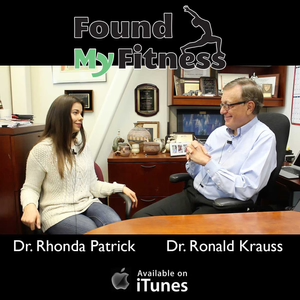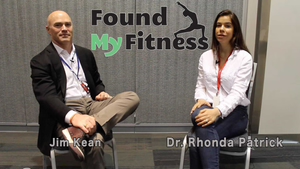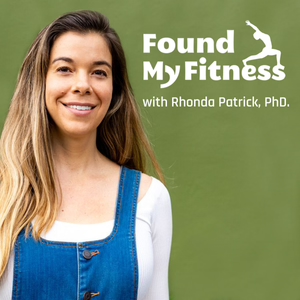
FoundMyFitness
Rhonda Patrick, Ph.D.


8 Listeners
All episodes
Best episodes
Top 10 FoundMyFitness Episodes
Goodpods has curated a list of the 10 best FoundMyFitness episodes, ranked by the number of listens and likes each episode have garnered from our listeners. If you are listening to FoundMyFitness for the first time, there's no better place to start than with one of these standout episodes. If you are a fan of the show, vote for your favorite FoundMyFitness episode by adding your comments to the episode page.
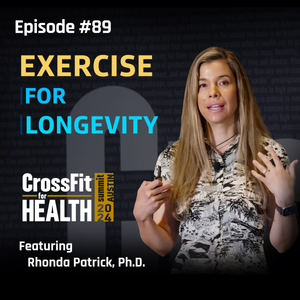
04/08/24 • 51 min
Download the 9-Page "Cognitive Enhancement Blueprint"
Discover my premium podcast, The Aliquot
Join over 300,000 people and sign up for my newsletter
I recently had the privilege of presenting at the CrossFit Health Summit, where I explored a constellation of factors contributing to longevity. In this context, I placed a special emphasis on the pivotal role of vigorous exercise throughout life.
Timestamps
- (00:00) Introduction
- (03:12) Why "below normal" cardio may be a great starting point
- (05:07) The simple math of 45 days of life extension (per 1 mL/kg/min VO2max)
- (06:12) Why poor cardiovascular fitness is nearly as bad as a chronic disease
- (06:52) Why zone 2 training may not improve VO2 max
- (08:08) Protocols for improving VO2 max quickly
- (09:10) How to estimate VO2 max in 12 minutes;
- (10:07) Reversing 20 years of heart aging
- (12:41) Blood pressure benefits of vigorous exercise
- (13:29) The BDNF brain benefits of high-intensity exercise
- (14:05) The signaling role of lactate production by muscle
- (16:13) How training effortfully improves focus & attention
- (17:23) Anti-cancer effects of vigorous exercise
- (18:11) Why shear stress kills circulating tumor cells
- (19:00) What if you exercise in short bursts all day long?
- (20:06) Why "exercise snacks" are a crucial pre- and post-mealtime activity
- (20:49) The best ways to improve mitochondrial biogenesis
- (21:47) The mortality benefits of breaking up sedentary time
- (26:17) Why the protein RDA is too low
- (29:07) Does omega-3 reduce muscle atrophy?
- (30:41) Why we should lift for aging and to prevent the 8% per decade decline of muscle
- (32:03) Is lifting heavy necessary for gaining muscle?
- (33:06) What the sauna has in common with exercise
- (34:45) Does the sauna enhance the benefits of exercise?
- (36:44) How heat shock proteins prevent plaque aggregation & slow muscle atrophy
- (38:23) Can sauna after resistance training boost hypertrophy?
- (39:06) Optimal sauna parameters
- (39:59) Comparing traditional saunas to infrared
- (40:59) Hot baths vs. saunas
- (42:19) Is EPA or DHA responsible for omega-3's effects on disuse atrophy?
- (43:53) Are endurance athletes at risk for cardiovascular injury?
- (44:57) What mechanisms are responsible for sauna's benefits?
- (47:08) Is a sauna temperature above 200 F too hot?
- (49:31) My recommended sauna temperature & duration

4 Listeners
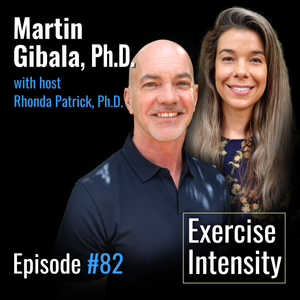
#082 The Science of Vigorous Exercise — Should We Train Hard or Train Long? | Martin Gibala, Ph.D.
FoundMyFitness
09/19/23 • 171 min
Dr. Martin Gibala is a muscle physiologist, professor, and kinesiology department chair at McMaster University in Hamilton, Ontario, Canada. He is best known for pioneering research on the health benefits of high-intensity interval training (HIIT) and his profound understanding of HIIT's physiological mechanisms. He is a co-author of the book "The One-Minute Workout."
In this episode, we discuss:
- (00:00) Introduction
- (11:00) What is high-intensity training?
- (11:53) Zone 2 vs. HIIT for VO2 max — which is better?
- (13:22) The vital role of vigorous exercise
- (14:40) Why VO2 max matters for longevity
- (17:45) Why athletes vs. exercisers benefit from different intensity distributions
- (22:09) Measuring maximum heart rate and VO2 max
- (30:31) How the heart adapts to HIIT to increase VO2 max
- (35:47) Why vigorous exercise accelerates mitochondrial adaptation
- (40:06) Enhancing fat oxidation and mitochondrial growth with vigorous exercise
- (44:22) How intensive exercise boosts fat breakdown
- (45:56) Is high-intensity exercise better for autophagy than fasting?
- (55:15) Exercise snacks
- (57:55) Why 'choosing the stairs' reduces early death (VILPA study)
- (1:00:39) Protocol for VO2 max
- (1:05:50) The effect of HIIT on muscle fiber types
- (1:10:18) How aging effects muscle fibers
- (1:14:09) Does high-intensity training produce an "afterburn effect?"
- (1:16:13) Why vigorous workouts are better for BDNF and cognition
- (1:23:15) Anti-metastatic cancer effects
- (1:50:23) Wingate training vs. reHIIT — a comparison of protocols
- (1:55:38) Perceived exertion vs. HRmax
- (1:59:23) Interval walking for people with type 2 diabetes
- (2:01:06) Contraindications of HIIT
- (2:05:06) Why preconditioning reduces risks from exercise
- (2:10:44) Can resistance training be a type of aerobic exercise?
- (2:16:24) Does cardio and strength training interfere with each other?
- (2:18:45) How many minutes per week of high-intensity training?
- (2:26:58) Are there sex differences and misconceptions in high-intensity training, for women?
- (2:27:42) Should post-menopausal women do H.I.I.T.?
- (2:27:47) Does intense exercise raise cortisol?
- (2:34:16) Bone density and osteoarthritis
- (2:36:40) Atrial fibrillation risk
- (2:39:20) Hypoxic training and blood flow restriction
- (2:40:45) Tips for training with joint issues
Show notes are available by clicking here
Join over 300,000 people and get the latest distilled information straight to your inbox several times per month: https://www.foundmyfitness.com/newsletter
Become a FoundMyFitness premium member to get access to exclusive episodes, emails, live Q+A’s with Rhonda and more: https://www.foundmyfitness.com/premium
Learn more about the premium podcast The Aliquot: https://www.foundmyfitness.com/aliquot
2 Listeners
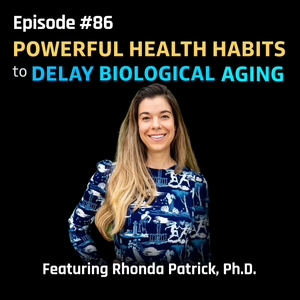
03/06/24 • 56 min
Download the 9-Page "Cognitive Enhancement Blueprint"
Discover my premium podcast, The Aliquot
Join over 300,000 people and sign up for my newsletter
In today's episode, I'm bringing you along to the American Academy of Anti-Aging Medicine's Longevityfest Conference, where I had the honor of presenting a keynote last December. We'll explore some foundational yet effective tactics to enhance longevity and prevent diseases. Additionally, we'll delve into more intensive lifestyle modifications that, despite their demands, offer significant longevity benefits.In this episode, I discuss:
- (00:00) Introduction
- (04:48) The importance of vitamin D
- (09:08) How vitamin D deficiency affects all-cause mortality risk
- (12:34) Optimal vitamin D levels & supplementation
- (14:20) Why magnesium deficiency impairs DNA damage repair
- (18:00) Dangers of inadequate omega-3 intake
- (20:17) The correct omega-3 index level
- (24:42) How to correct vitamin D, omega-3, & magnesium inadequacies
- (26:27) Vigorous exercise is the best longevity drug
- (28:00) How increasing VO2 max affects life expectancy
- (32:46) Protocols for increasing VO2 max
- (35:37) How to measure VO2 max
- (36:44) What it takes to reverse 20 years of heart aging
- (39:41) Blood pressure benefits of vigorous exercise
- (40:58) The BDNF brain benefits of vigorous exercise
- (44:08) How vigorous intensity exercise improves focus & attention
- (45:21) Exercise protocols for maximizing BDNF
- (46:23) Anti-cancer effects of vigorous exercise
- (48:40) The benefits of exercise snacks
2 Listeners

12/05/23 • 62 min
Download the 9-Page "Cognitive Enhancement Blueprint" companion guide at bdnfprotocols.com.
This episode challenges common perceptions about exercise, delving deep into the benefits of vigorous exercise for not just physical health but also brain function, aging, and even cancer prevention. It tackles fundamental questions, like what genetic and metabolic adaptations occur with vigorous exercise and how it can contribute to combating heart's age-related changes. We also unpack how these rigorous exercises affect glucose transport, mitochondrial health, and brain health at an intricate level. Lastly, it introduces practical applications like the Norwegian 4x4 interval training protocol, the benefits of "exercise snacks," and how to incorporate vigorous-intensity exercise into everyday life.
In this episode, I discuss:
(00:00) Introduction
(04:34) What differentiates "vigorous" from "zone 2" training
(08:34) Ties between VO2 max & life expectancy
(11:55) Why zone 2 training doesn't guarantee VO2 max improvements
(14:17) How to balance zone 2 training & vigorous-intensity workouts
(16:17) Why the Norwegian 4x4 protocol may improve your VO2 max
(19:35) Evidence-based methods to estimate VO2 max outside a lab.
(22:33) What it takes to reverse 20 years of heart aging: a two-year protocol
(28:24) HIIT and type 2 diabetes – how vigorous exercise can reduce risk.
(29:38) The mitochondria argument: HIIT vs. Zone 2 – which intensity is better?
(32:09) Rethinking the 80-20 rule for everyday exercisers (less zone 2, more effort)
(35:18) The role of high-intensity workouts in enhancing mitophagy
(38:03) Why lactate accumulation from higher training intensity benefits the brain
(40:28) Why the "glucose sparing" effect of lactate benefits brain injury and aging
(43:26) The unique BDNF benefits of high-intensity exercise: the lactate advantage
(44:42) The angiogenic effects of VEGF on the blood-brain barrier (in response to lactate)
(46:58) The greater the exercise intensity, the greater the myokine release
(49:48) How physical activity affects death risk in breast & colorectal cancer survivors
(50:56) How vigorous aerobic exercise kills circulating tumor cells
(52:36) Why exercise reduces depression and neurotoxicity (kynurenine mechanism)
(54:13) The surprising power of "exercise snacks" against mortality
(1:01:36) Download "The Cognitive Enhancement Blueprint" at bdnfprotocols.com
Show notes are available by clicking here
Get the latest distilled information straight to your inbox several times per month: https://www.foundmyfitness.com/newsletter
Become a FoundMyFitness premium member to get access to exclusive episodes, emails, live Q+A’s with Rhonda and more: https://www.foundmyfitness.com/premium
Learn more about our premium podcast, The Aliquot: https://www.foundmyfitness.com/aliquot
1 Listener

#055 COVID-19 Q&A #2 - Antibody-Dependent Enhancement, Cross-Immunity, Immunity Duration & More
FoundMyFitness
06/10/20 • 55 min
This is a continuation of the last episode where Dr. Patrick took questions from newsletter subscribers around the ongoing pandemic and tried to add value by talking about some of the recent research, among other things.
In this episode, you'll discover:
- (00:00) Introduction
- (04:06) Data surrounding SARS-CoV-2 duration
- (06:30) SARS-CoV-2 and long-lasting immunity
- (11:27) Genetic causes of immune variation
- (14:27) Previous viral exposure and cross-immunity to SARS-CoV-2
- (18:57) Antibody-dependent enhancement and SARS-CoV-2 relevance
- (21:50) Sleep deprivation impairs immunity & vaccine efficacy
- (23:42) Microbiome composition and immune function
- (28:22) The differential effects of exercise intensity and duration on immune regulation
- (34:10) Micronutrient inadequacies promote immune dysregulation
- (46:32) Effects of sex and age in immune regulation
- (48:59) Controversy surrounding hypertension drugs such as ACE inhibitors and COVID-19
- (52:28) ARDS and long-term lung damage
If you’re interested in learning more, you can read the full show notes here.
Join over 300,000 people and get the latest distilled information straight to your inbox weekly: https://www.foundmyfitness.com/newsletter
Become a FoundMyFitness premium member to get access to exclusive episodes, emails, live Q+A’s with Rhonda and more: https://www.foundmyfitness.com/crowdsponsor

1 Listener
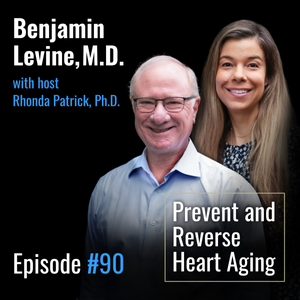
05/28/24 • 151 min
Download the 13-Page "Omega-3 Supplementation Guide"
Discover my premium podcast, The Aliquot
Join over 300,000 people and sign up for my newsletter
Today's guest, Dr. Benjamin Levine, has shown that with the right exercise protocol, people who were sedentary most of their lives could reverse up to 20 years of heart aging. Dr. Levine is one of the world's leading experts in understanding how the heart adapts under a variety of conditions, whether that's exercise, elite athleticism, or hospital bedrest. Or even highly exotic conditions, like prolonged exposure to microgravity. He is the founding director of the Institute for Exercise and Environmental Medicine at UT Southwestern in Dallas.
Timestamps
- (00:00) Introduction
- (06:21) Bed rest vs. aging
- (11:40) Does exercise protect against long COVID?
- (17:14) How 12 weeks of bed rest affects heart size
- (18:42) Why a brand-new rubber band mimics a lifetime of endurance training
- (22:14) The exercise dose that preserves youthful cardiovascular structure
- (24:22) The exercise regimen that reversed 20 years of heart aging
- (28:05) What it takes to reverse vascular age by 15 years
- (33:29) Benefits of starting an exercise regimen in your 70s
- (39:17) Risks of high-intensity exercise
- (42:42) Balancing high-intensity & moderate-intensity training
- (47:39) Training for health vs. training for performance
- (49:58) Make exercise a part of your personal hygiene
- (51:01) Why does VO2 max correlate with longevity?
- (58:29) The 2018 JAMA study on cardiorespiratory fitness & mortality
- (1:04:06) How does change in fitness over time affect mortality?
- (1:06:19) Why exercise non-responders should consider "increasing the dose"
- (1:10:08) The 2 limiting factors for improving VO2 max in competitive athletes
- (1:17:20) Heart adaptations in purely strength-trained vs. endurance athletes
- (1:23:09) Why pure strength-trainers should incorporate endurance training
- (1:26:53) How strength training affects blood pressure
- (1:31:27) How exercise influences cardiac output in mitochondrial myopathy patients
- (1:33:25) Does CrossFit count as endurance training?
- (1:35:50) What's the best exercise for improving blood pressure?
- (1:40:57) Lifestyle strategies for treating hypertension
- (1:43:26) Why recovery is key to reaping the benefits of a training stimulus
- (1:47:22) The best indicator of being overtrained
- (1:54:46) Why HRV is a poor indicator of recovery
- (2:00:02) Why do men tend to be faster runners than women?
- (2:03:34) Can women achieve similar aerobic exercise benefits doing 2x less than men?
- (2:05:06) Are there cardiovascular benefits of HRT in women?
- (2:08:45) Exercise volume vs. coronary plaque calcification
- (2:15:35) How exercise duration & intensity affect coronary calcium levels
- (2:18:48) Why high exercise duration & intensity increases risk of Afib
- (2:26:00) Why you shouldn't become an endurance athlete to "live longer"

1 Listener
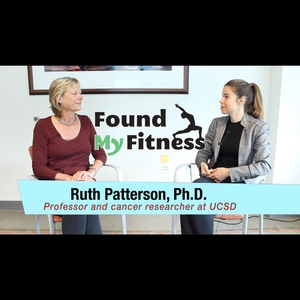
07/08/16 • 47 min
Today's episode features Dr. Ruth Patterson, a professor in the UC San Diego Department of Family Medicine and Public Health as well as Associate Director of Population Sciences and leader of the Cancer Prevention program at Moores Cancer Center at UC San Diego Health. If you enjoyed my last episode with Dr. Satchin Panda, I have good news! This will also be a great episode for you, since we talk about some similar ideas, but focus more on the human side of things, especially when it comes to time-restricted eating, since Dr. Patterson does primarily clinical research.
In this 45-minute podcast, we talk about...
- The importance of time-restricted eating as a practical public health intervention, mostly for it's ease of implementation, that may have a widespread impact on disease risk.
- Why you should probably make sure your time-restricted eating window occurs earlier in the day, rather than later.
- How the first 5% drop in weight loss can have disproportionately large effects on the metabolic factors associated with breast cancer risk when compared with subsequent weight loss.
- The association of longer fasting durations beginning earlier in the evening and improved sleep in humans, as well as spontaneous physical activity in their day-to-day lives.
- The relationship between metabolism and breast cancer risk.
- The effect of lifestyle factors, such as obesity, physical activity, what and even when you eat, whether or not you smoke tobacco... and how even modest changes, such as consuming food earlier in the day and only during an 11-hour window, can decrease breast cancer risk and recurrence by as much as 36%.
- The importance of starting your fast earlier in the evening, and how an earlier eating window has been shown to correlate to reductions in inflammatory markers.
- The association of higher circulating insulin levels with breast cancer risk, and how insulin itself has an important relationship with estrogen by affecting the levels of sex-hormone binding globulin.
- The dangers of having a cellular environment that is inflamed, as the case is with the obese, and simultaneously having elevated cellular growth signals, which is also characteristic of the hormonal milieu of the obese.
- The surprisingly small role heredity plays in determining overall risk of breast cancer when compared to lifestyle factors.
- How healthful lifestyle habits, like choosing to eat during the right window, ultimately helps us trend our risk for many of the diseases of old age in the correct direction instead of influencing only one or another.
If the concept of time-restricted eating especially piques your interest, make sure to...
- Check out the podcast released just prior to this one: Dr. Satchin Panda on Time-Restricted Feeding and Its Effects on Obesity, Muscle Mass & Heart Health.
- Make sure your data points go to good use! Visit myCircadianClock.org to learn how you can, by committing to a minimum of a 14 week "intervention" and submitting pictures of your food from your iPhone or Android phone, move human research on time-restricted eating forward.
Huge special thanks to Dr. Ruth Patterson for coming on. Enjoy the podcast!
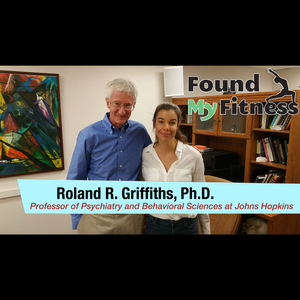
01/19/17 • 77 min
Dr. Roland R. Griffiths is a clinical pharmacologist at Johns Hopkins and has been researching mood-altering compounds for over 40 years. As an unusually prolific scientist, having published over 360-times, he's also responsible for having started the psilocybin research program at Johns Hopkins nearly 2 decades ago.
In this 1-hour and 15-minute podcast, we discuss…
- 00:01:03 - the broader story of Dr. Griffiths 40 years of mood-altering drug research, including what got him started and how taking up a meditation practice ultimately influenced the eventual focuses of his research.
- 00:02:22 - the effect psilocybin has had in clinical trials in eliciting so-called mystical experiences that can act as a long-term catalyst for meaningful spiritual change and is amenable to being reproduced and clinically studied in a prospective manner.
- 00:03:45 - what distinguishes psilocybin from other drugs, particularly when reflecting backward on the experience months afterward.
- 00:05:11 - the process by which Dr. Griffiths and his team create an appropriate “setting” and facilitate feelings of safety for those participating in his trials.
- 00:06:42 - the elusive fundamental nature of a classical psychedelic experience whereby people often simultaneously describe the experience as ineffable (indescribable) but yet also often assign it a truth value that may even exceed that of everyday consensus reality.
- 00:07:36 - a description of the core features of a classical mystical experience that overlap with those found in a mystical experience induced by psilocybin.
- 00:08:58 - the qualities of the experience that Dr. Griffiths believes to most underlie the “reorganizational” potential it can have.
- 00:10:55 - the interesting potential areas for scientific exploration that the reproducibility of the psilocybin experience makes the substance amenable to.
- 00:11:25 - the promise psilocybin has shown as an effective therapeutic for anxiety and depression in patients with life-threatening cancer and also treatment-resistant depression in otherwise healthy patients (00:18:46).
- 00:13:04 - the lack of rigor in the very early trials on these compounds and the way in which cultural stigma surrounding psychedelic drugs ultimately played a role in impeding real, substantive clinical research for decades afterward.
- 00:16:31 - the long-term resilience of the antidepressant and anxiolytic effect, lasting six months and possibly even longer.
- 00:21:01 - the effect psilocybin has demonstrated in animal studies to increase hippocampal neurogenesis and enhance extinction of trace fear conditioning.
- 00:23:07 - the somewhat unintuitive neurobiological mechanism that may tie together some of the antidepressant properties of both psilocybin and ketamine, an anesthetic currently being studied as a rapid-onset antidepressant.
- 00:25:16 - whether or not the mystical subjective experiences are necessary for drugs like psilocybin to exert their antidepressant or anxiolytic effects.
- 00:26:43 - what the default mode network is and what its pattern of activity is in depression, long-term meditators, and after the acute use of psilocybin.
- 00:32:16 - the hard problem of consciousness.
- 00:37:26 - the challenge of finding the neurological correlates to match the phenomenology of individual’s subjective experiences.
- 00:38:16 - the promise psilocybin has shown in a small trial on smoking cessation where 60% of the treatment group were still abstinent a year afterward and plans Dr. Griffiths has to expand this area of research
- 00:41:10 - the possibility that the “reorganizational nature” of these experiences may open up new avenues as trials continue to try to embed the experience within different therapeutic contexts.
- 00:44:02 - the roadmap to FDA approval for use of psilocybin as a medication, particularly in the context of cancer-associated depression and anxiety.
- 00:45:05 - the risks inherent in taking psilocybin and the frequency of self-reported negative experiences in the general population.
- 00:47:22 - the criteria Dr. Griffiths and his colleagues use when screening for volunteers to participate in his studies involving psilocybin.
- 00:49:21 - the inability for clinicians to predict who is at risk of having challenging experiences defined by fear and anxiety (“bad trip”) and whether or not it is desirable, in terms of achieving a therapeutic outcome, to prevent these types of experiences altogether or not.
- 00:51:43 - the sort of dosages used in the trials.
- 00:54:45 - the clever ways devised by Dr. Griffiths to placebo control trials where expectation itself can affect outcome.
- 00:57:45 - some of the interesting anecdotes gleaned from Dr. Griffiths’ working with long-term meditators participating in the psilocybin tria...
Show more best episodes

Show more best episodes
FAQ
How many episodes does FoundMyFitness have?
FoundMyFitness currently has 154 episodes available.
What topics does FoundMyFitness cover?
The podcast is about Health & Fitness, Exercise, Nutrition, Sleep, Depression, Medicine, Fitness, Podcasts, Fasting, Diet, Health and Longevity.
What is the most popular episode on FoundMyFitness?
The episode title '#089 Why Exercise Intensity Matters for Longevity | CrossFit for Health 2024' is the most popular.
What is the average episode length on FoundMyFitness?
The average episode length on FoundMyFitness is 77 minutes.
How often are episodes of FoundMyFitness released?
Episodes of FoundMyFitness are typically released every 12 days, 23 hours.
When was the first episode of FoundMyFitness?
The first episode of FoundMyFitness was released on Jul 22, 2014.
Show more FAQ

Show more FAQ
